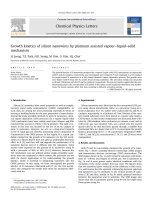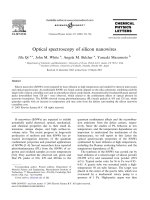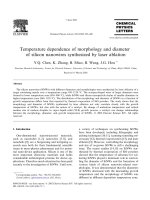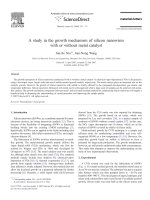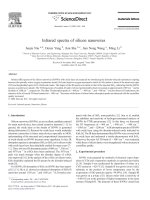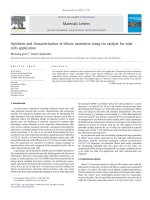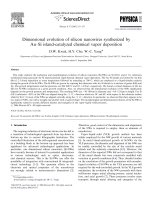Synthesis of Silicon nanowires for sensornanowires for sensorapplications
Bạn đang xem bản rút gọn của tài liệu. Xem và tải ngay bản đầy đủ của tài liệu tại đây (1.97 MB, 25 trang )
Synthesis of Silicon
nanowires for
sensor
nanowires for
sensor
applications
Anne
Claire
Salaün
Anne
-
Claire
Salaün
Nanowires Team
Laurent
Pichon (Pr),
Laurent
Pichon
(Pr),
Régis Rogel (Ass.Pr),
Anne-Claire Salaün (Ass. Pr)
CMC2 - November 25, 2010 - Barcelona, Spain
1111
FRONTIER-2009, Nov 29-Dec 3, 2009, Sendai, Japan
Ph-D positions:
Fouad Demami, Liang Ni,
Gertrude Godem-Wenga
IETR - Institut d’Electronique et de Télécommunications de Rennes
FRANCE
Rennes
Rennes
CMC2 - November 25, 2010 - Barcelona, Spain
2222
IETR - Institut d’Electronique et de Télécommunications de Rennes
FRANCE
MicroelectronicsMicroelectronics and and MicrosensorsMicrosensors
DepartmentDepartment
Two research teams involved
Devices
Development
of
process
fabrication
Microsensors
Development
of
innovative
sensors
Development
of
process
fabrication
Development
of
innovative
sensors
Research
fields
covered
:
Competences
and know
-
how
Research
fields
covered
:
Micro/nano electronics
Microtechnology/Microfluidic
Competences
and
know
-
how
Synthesis of Si related materials (thin films,
nano-objects)
Sensors
Microsystems and systems
Electronic on plastic substrates
Si & Ge low temperature technology on
flexible substrate
Actuation and detection techniques
C
CMC2 - November 25, 2010 - Barcelona, Spain
3333
C
hemical and biological detection
Introduction
ContextContext
• Owing to their physical and electrical properties, silicon nanowires represent
• a promising material with strong potential
• large variety of applications in future nanoelectronic devices
• Fabrication of innovative devices based on silicon nanowires with remarkable
electronic properties.
Ntiithlb
•
N
ew
t
op
i
c
i
n
th
e
l
a
b
Our objectivesOur objectives
• Synthesis of silicon nanowires
• Study and optimization of their electrical performances
• Fabrication of electronic devices (resistors, field-effect transistors)
•
Development of innovative micro
sensors (chemical biological)
CMC2 - November 25, 2010 - Barcelona, Spain
4444
•
Development
of
innovative
micro
-
sensors
(chemical
,
biological)
Silicon nanowires
Benefits of silicon nanowires (SiNWs)Benefits of silicon nanowires (SiNWs)
• High surface / volume ratio: surface phenomena predominate
• Possibility of surface functionalization for biological applications
•
Development of
nanosensors
with high sensitivity
Development
of
nanosensors
with
high
sensitivity
• Compatibility with CMOS technologies
Silicon nanowires synthesis: 2 approaches
Top
-
down Approach
Bottom
-
up Approach
Top
down
Approach
Bottom
up
Approach
Starts from bulk materials and scales down
the
p
atterned areas
Growth technique
from molecular precursors using
ti l
tl t
p
nanopar
ti
c
l
es as ca
t
a
l
ys
t
s
Optical and x-ray lithography
E-beam and ion-beam lithography
S i b lith h
Layer-by-layer self assembly
Molecular self assembly
Di t bl
CMC2 - November 25, 2010 - Barcelona, Spain
5555
S
cann
i
ng pro
b
e
lith
ograp
h
y
Printing and imprinting
Di
rec
t
assem
bl
y
Coating and growth
Outline
Introduction
• Context
• Benefits of silicon nanowires (SiNWs)
Sili i b tt
h
Sili
con nanow
i
res:
b
o
tt
om-up approac
h
• Synthesis method
• Fabrication of silicon nanowires based resistors
El t i l h t i ti
•
El
ec
t
r
i
ca
l
c
h
arac
t
er
i
za
ti
on
• Chemical species detection
Silicon nanowires: top
down approach
Silicon
nanowires:
top
-
down
approach
• Synthesis method
• Fabrication of silicon nanowires based resistors
•
Fabrication of nanowires Thin Film Transistors (
SiNW
TFT)
•
Fabrication
of
nanowires
Thin
Film
Transistors
(
SiNW
-
TFT)
• Electrical characterization
• Chemical species detection
CMC2 - November 25, 2010 - Barcelona, Spain
6666
SiNW synthesis : Bottom-up
• Nanowire synthesis is achieved by a vapor-liquid-solid (VLS) process
Bottom-up approach Bottom-up approach
A droplet of a liquid catalyst is put in contact with gaseous precursor molecules
A
droplet
of
a
liquid
catalyst
is
put
in
contact
with
gaseous
precursor
molecules
.
SiNWs are synthesized using gold (Au) as metal catalyst and silane (SiH
4
) as precursor gas
in a hot wall LPCVD reactor.
CMC2 - November 25, 2010 - Barcelona, Spain
7777
SiNW synthesis : Bottom-up
The diameter of the nanowire, grown by the VLS process, is given by the diameter of
the gold nanoparticles.
Nanowire
Nanowire
Au
• Gold deposited by thermal evaporation (thickness below 5 nm),
• Growth in LPCVD reactor with silane at 480°C (pressure: 40Pa)
• Diameter : about 100 nm, various orientation, length can exceed 10 µm
CMC2 - November 25, 2010 - Barcelona, Spain
8888
SiNW synthesis : Bottom-up
Advantage of the VLS method
:
Advantage
of
the
VLS
method
:
• Possibility of selective doping (n- or p-type) of the nanowires, by controlled injection
of the dopant precursor gas
• High quality single crystalline nanowires with well-controlled composition and
electronic properties
Challenges:
•
Controlling diameter and orientation of the nanowires which impede the success of
Controlling
diameter
and
orientation
of
the
nanowires
which
impede
the
success
of
the fabrication of nanowire arrays with high degree of reproducibility.
CMC2 - November 25, 2010 - Barcelona, Spain
9999
SiNW synthesis : Bottom-up
Highly in-situ doped
polysilicon
Fabrication of nanowires based resistors
First mask
Definition of the comb shape
Electrodes geometry on a SiO
2
capped substrate
SiO
2
polysilicon
Silicon substrate
Au
Second mask
Thin film Au local deposition after lift-of
f
technique
nanowires
nanowires
Growth of SiNWs by LPCVD.
Silicon nanowire network: used to interconnect electrodes
CMC2 - November 25, 2010 - Barcelona, Spain
10101010
Silicon substrate or glass substrate (maximum process temperature 600°C)
SiNW synthesis : Bottom-up
• Different interdigitated structures
can be achieved, varying number
of teeth and local deposition of
ld
go
ld
5,0x10
-9
1,0x10
-8
Au thickness
: 5nm
-5,0x10
-9
0,0
Current (A)
CMC2 - November 25, 2010 - Barcelona, Spain
11111111
-1,0 -0,5 0,0 0,5 1,0
-1,0x10
-8
Voltage (V)
SiNW synthesis : Bottom-up
Thin Film Transistors with Nanowires
Out
p
ut characteristics
Source
Drain
p
1,5x10
-7
Source
1,0x10
-7
VG=0V
VG=10V
ds
0,0
5,0x10
-8
VG=-20V
I
Gate
Highly
doped
23456
Vds
Gate
Highly
doped
silicon substrate
• Field effect but bad electrical contact
• Surface sensitive to charges in ambiance
CMC2 - November 25, 2010 - Barcelona, Spain
12121212
SiNW synthesis : Bottom-up
Silicon Nanowire as gas sensor
• Main interest of SiNWs rests on their high surface that can be sensitive to charges
1,0x10
-
7
smoke
10
10
vacuum
SiNWs device exposed to smoke SiNWs device exposed to ammonia
6,0x10
-8
8,0x10
-8
t
(A)
air
10
9
n
ce ()
Reversible
trend
2,0x10
-8
4,0x10
-8
Curren
t
i
10
8
Resista
n
trend
-250 0 250 500 750 100012501500175020002250
0,0
Time (sec)
21 min
a
i
r
0 5 10 15 20 25 30
10
7
Time (min)
NH
3
ammonia and smoke may act as chemical gates:
species act as electrons donor (reducing agents) at the SiNWs surface.
CMC2 - November 25, 2010 - Barcelona, Spain
13131313
positively charged gas molecules binded on SiNWs surface can modulate the conductance
Outline
Introduction
• Context
• Benefits of silicon nanowires (SiNWs)
Sili i b tt
h
Sili
con nanow
i
res:
b
o
tt
om-up approac
h
• Synthesis method
• Fabrication of silicon nanowires based resistors
El t i l h t i ti
•
El
ec
t
r
i
ca
l
c
h
arac
t
er
i
za
ti
on
• Chemical species detection
Silicon nanowires: top
down approach
Silicon
nanowires:
top
-
down
approach
• Synthesis method
• Fabrication of silicon nanowires based resistors
•
Fabrication of nanowires Thin Film Transistors (
SiNW
TFT)
•
Fabrication
of
nanowires
Thin
Film
Transistors
(
SiNW
-
TFT)
• Electrical characterization
• Chemical species detection
CMC2 - November 25, 2010 - Barcelona, Spain
14141414
SiNW synthesis : Top-down
Top-down approach Top-down approach
• starts from bulk materials and scales down the patterned areas
• Advantages
•
high
yield high
uniformity and well
aligned production of nanowires
•
high
-
yield
,
high
-
uniformity
,
and
well
-
aligned
production
of
nanowires
• this approach is more promising for mass production of highly uniformed
nanowire arrays and nanowire-based devices.
Sidewall spacer formation techniqueSidewall spacer formation technique
• This technique uses anisotropic dry etching
• Low cost (does not require the use of high cost lithographic techniques)
• Compatible with conventional CMOS technology
• Benefits of excellent homogeneity and reproducibility of conformal CVD
processes
CMC2 - November 25, 2010 - Barcelona, Spain
15151515
SiNW synthesis : Top-down
Fabrication of silicon nanowires by the sidewall spacers formation technique
RIE etching
Polysilicon nanowires
RIE etching
Si
l
N
+
Undoped polysilicon
Si
po
l
y
N
Silicon oxide
APCVD oxide
Monocristalline substrate
CMC2 - November 25, 2010 - Barcelona, Spain
16161616
SiNW synthesis : Top-down
Optmization of the steepness:
dry etching parameters (pressure, power)
+
Accurate control of the Si-poly etching : Nanowire
N
+
Si poly
oxide
substrate
Oxide
Nanowires with curvature radius ~ 50 nm
CMC2 - November 25, 2010 - Barcelona, Spain
17171717
SiNW synthesis : Top-down
Fabrication of Nanowires resistors
8
1,5x10
-8
2,0x10
-8
Current (A)
3 µm
5 µm
10 µm
Nitride LPCVD
Undoped Si- poly
-1,0 -0,5 0,0 0,5 1,0
9
0,0
5,0x10
-9
1,0x10
-
8
Vlt (V)
10
µm
20 µm
N+ Si-poly
APCVD
oxide
8
-1,5x10
-8
-1,0x10
-8
-5,0x10
-
9
V
o
lt
age
(V)
-2,0x10
-
8
Current versus voltage
f
o
r4l
e
n
gt
h
s
of
s
ili
co
nn
a
n
o
wir
es
o
egts
o
sco
ao es
Thermal oxide
Silicon nanowires
CMC2 - November 25, 2010 - Barcelona, Spain
18181818
Si substrate
SiNW synthesis : Top-down
Silicon Nanowire as gas sensor
SiNWs device exposed to smoke SiNWs device exposed to ammonia
10
13
NH
3
exposure
1
0
10
10
11
smoke exposure
10
12
vacuum
s
istance ()
10
8
10
9
10
a
nce ()
10
10
11
Re
s
10
6
10
7
Resist
a
vacuum vacuum
0 1020304050607080
10
10
Time (min)
0 102030405060
10
5
Time (min)
Ammonia and smoke may act as chemical gates: donor of electrons
Carrier transport strongly depends on structural nanowires defects (polysilicon grain boundaries)
CMC2 - November 25, 2010 - Barcelona, Spain
19191919
Gas molecules adsorbed may play a significant role in decreasing the potential barrier height at the grain
boundaries between two grains
SiNW synthesis : Top-down
V
g
s = 0V
nanowires
Nanowires Field effect transistors using sidewall spacer process
2,0x10
-8
2,5x10
-8
3,0x10
-8
3,5x10
-8
g
Vgs = 1V
Vgs = 2V
Vgs = 3V
Vgs = 4V
00
5,0x10
-9
1,0x10
-8
1,5x10
-8
Ids (A)
D
G
N
+
Substrate
S
1E-7
01234
-5,0x10
-9
0
,
0
Vds (volts)
N
Substrate
1E-9
1E-8
Ids (A)
Vds = 4V
1E
-
11
1E-10
CMC2 - November 25, 2010 - Barcelona, Spain
20202020
-10 0 10 20 30 40
1E 11
Vgs (volts)
SiNW synthesis : Top-down
APCVD oxide
To increase the surface…
Nanowire
Nitride
Sacrificial oxide
p
rocess
p
CMC2 - November 25, 2010 - Barcelona, Spain
21212121
Conclusions and future directions
Nanowires synthesisNanowires synthesis
• Feasibility of silicon nanowires for both synthesis methods explored
• Electrical behavior show good potential for electronic devices
• Curvature radius has to be lowered to observe the nanometric size effects on
the electrical
behaviour
the
electrical
behaviour
Future directionsFuture directions
• Detection of chemical and biological species (areas of healthcare, life sciences)
• Nanowires: new opportunities in this interdisciplinary area
•
diameters comparable to those of the biological/chemical species being sensed
diameters
comparable
to
those
of
the
biological/chemical
species
being
sensed
.
• Devices based on nanowires: ultrasensitive electrical sensors for the detection
of biological and chemical species.
•
ability to bind
analytes
on
their
surface
•
-
ability
to
bind
analytes
on
their
surface
• - direct electrical detection (without using labels)
• - low concentrations of DNA, proteins or viruses
•-ra
p
id anal
y
sis of these s
p
ecies
CMC2 - November 25, 2010 - Barcelona, Spain
22222222
py p
Conclusions and future directions
conductance
time
P-type FET : the binding of target molecules (negative
charges) leads to an accumulation of holes in the nanowire:
conductance
Detection of DNA-hybridization
Pb
bi di
No-complementary
tt
Complementary
T
t
P
ro
b
e
bi
n
di
ng
t
arge
t
(no hybridization)
T
arge
t
(hybridization)
CMC2 - November 25, 2010 - Barcelona, Spain
23232323
Conclusions and future directions
Antibody receptor
Nanowire modified with specific
surface receptors
Detection of proteins
surface
receptors
immobilization of antibodies
binding of antigens
Binding of a protein
Biological sensors
• Specific sensing achieved by linking a recognition group to the surface of the
nanowire
•
The nanowire surface can be modified with a variety of linker molecules
• Specific sensing achieved by linking a recognition group to the surface of the
nanowire
•
The nanowire surface can be modified with a variety of linker molecules
Biological
sensors
The
nanowire
surface
can
be
modified
with
a
variety
of
linker
molecules
(bioaffinitive agents): functionalization
• Significant signal changes with the binding of molecules
• SiNWs development could significantly impact areas of electronics, genomics,
biomedical diagnostics drug discovery
The
nanowire
surface
can
be
modified
with
a
variety
of
linker
molecules
(bioaffinitive agents): functionalization
• Significant signal changes with the binding of molecules
• SiNWs development could significantly impact areas of electronics, genomics,
biomedical diagnostics drug discovery
CMC2 - November 25, 2010 - Barcelona, Spain
24242424
biomedical
diagnostics
,
drug
discovery
biomedical
diagnostics
,
drug
discovery
Thank you for your attention
Thank
you
for
your
attention
CMC2 - November 25, 2010 - Barcelona, Spain
25252525

